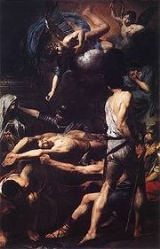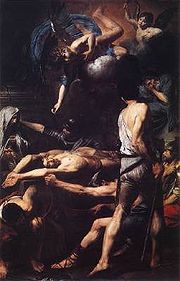
Valentin de Boulogne
Encyclopedia

France
The French Republic , The French Republic , The French Republic , (commonly known as France , is a unitary semi-presidential republic in Western Europe with several overseas territories and islands located on other continents and in the Indian, Pacific, and Atlantic oceans. Metropolitan France...
painter
Painting
Painting is the practice of applying paint, pigment, color or other medium to a surface . The application of the medium is commonly applied to the base with a brush but other objects can be used. In art, the term painting describes both the act and the result of the action. However, painting is...
.
Origins
Valentin was born in CoulommiersCoulommiers
Coulommiers is a commune in the Seine-et-Marne department in the Île-de-France in north-central France.It is also the name of a cheese of the Brie family produced in and around that city.-Twin towns:Coulommiers was twinned with Leighton Buzzard in 1958...
, France, where he was baptised in the parish of Saint-Denys on January 3, 1591, making 1590 his likely year of birth. The family name, also spelled Boullogne and Boulongne, appears to originate from Boulogne-sur-Mer
Boulogne-sur-Mer
-Road:* Metropolitan bus services are operated by the TCRB* Coach services to Calais and Dunkerque* A16 motorway-Rail:* The main railway station is Gare de Boulogne-Ville and located in the south of the city....
, a city in northern France in the colony of Pas-de-Calais, though the family had dwelt at Coulommiers since at least 1489. His father, also named Valentin, and his uncle Jean were both painters.
In Italy
It can be presumed that Valentin would have first started painting in his father's studio prior to moving to ParisParis
Paris is the capital and largest city in France, situated on the river Seine, in northern France, at the heart of the Île-de-France region...
or Fontainebleau
Fontainebleau
Fontainebleau is a commune in the metropolitan area of Paris, France. It is located south-southeast of the centre of Paris. Fontainebleau is a sub-prefecture of the Seine-et-Marne department, and it is the seat of the arrondissement of Fontainebleau...
, and before leaving for Italy
Italy
Italy , officially the Italian Republic languages]] under the European Charter for Regional or Minority Languages. In each of these, Italy's official name is as follows:;;;;;;;;), is a unitary parliamentary republic in South-Central Europe. To the north it borders France, Switzerland, Austria and...
. The first specific mention of Valentin's being there in Italy is in the stati d'anime for 1620, when he was living in the parish of Santa Maria del Popolo. Prior to that date it can only be speculated on his whereabouts and activities.
While studying in Italy, Valentin was under the influence of Michelangelo Merisi da Caravaggio and Bartolomeo Manfredi
Bartolomeo Manfredi
Bartolomeo Manfredi was an Italian painter, a leading member of the Caravaggisti of the early 17th century.Manfredi was born in Ostiano, near Cremona...
, and studying under Simon Vouet
Simon Vouet
Simon Vouet was a French painter and draftsman, who today is perhaps best remembered for helping to introduce the Italian Baroque style of painting to France.-Life:...
. Who Valentin idolized and who he worked on, shows repeatedly in his own work. Caravaggio's early career as a painter focused on portraits and still-life, and is best known for becoming an influential religious painter.
Influences

Caravaggio
Caravaggio used a"bold, naturalistic style, which emphasized the common humanity of the apostles and martyrs, flattered the aspirations of the Counter-ReformationCounter-ReformationThe Counter-Reformation was the period of Catholic revival beginning with the Council of Trent and ending at the close of the Thirty Years' War, 1648 as a response to the Protestant Reformation.The Counter-Reformation was a comprehensive effort, composed of four major elements:#Ecclesiastical or...
Church, while his vivid chiaroscuro enhanced both three-dimensionality and drama, as well as evoking the mystery of the faith." Caravaggio "followed a militantly realist agenda, rejecting both MannerismMannerismMannerism is a period of European art that emerged from the later years of the Italian High Renaissance around 1520. It lasted until about 1580 in Italy, when a more Baroque style began to replace it, but Northern Mannerism continued into the early 17th century throughout much of Europe...
and the classicizing naturalism" and "in the first 30 years of the 17th century his naturalistic ambitions and revolutionary artistic procedures attracted a large following from all over Europe."
Several centuries later, Caravaggio is still studied with the same awe he invoked so long ago. While Caravaggio was not the only painter Valentin looked to, another was Bartolomeo Manfredi
Bartolomeo Manfredi
Bartolomeo Manfredi was an Italian painter, a leading member of the Caravaggisti of the early 17th century.Manfredi was born in Ostiano, near Cremona...
.
Manfredi
Manfredi was another Italian painter, who in the 17th century was known throughout Italy and beyond as Caravaggio's closest follower with his works being highly prized and widely collected."More than simply aping Caravaggio's style, Manfredi reinterpreted his subjects and rendered new ones, drawing upon Caravaggio's naturalism and dramatic use of chiaroscuro."
His paintings were often praised by his contemporaries as equal to Caravaggio's and he was later emulated and imitated by other Roman Caravaggisti during the 1610s and 1620s. Manfredi never inscribed his paintings and by the 18th century his works were forgotten or confused with those of Caravaggio himself. Attempts to identify his pictures have proven difficult. In Manfredi's later period he would adopt a common theme from Caravaggio, scenes taking place in taverns, dramatically lit canvases with a penchant for portraying ordinary people, even religious subjects, and Manfredi would paint his figures large, and close to the surface of the picture to involve the viewers in the action.
Vouet
While Caravaggio and Manfredi may have influenced the style and themes that would become common in Valentin's work. It was Simon Vouet, a Frenchman, who Valentin would study under. In his time, Vouet was considered a leading French painter, today he is now known more for his influence on French painting than for his works. Vouet's earliest work show the influence of Caravaggio, where he was part of the movement. Vouet would use the dramatic contrasts of light, the restricted palette of blacks, browns whites, the realistic anatomical studies drawn from life and the lack of any attempt to achieve a decorative layout were part of the study of Caravaggio.Valentin's work also emulated Caravaggio and in an ironic way, his own life. Valentin was had success with a type of composition invented by Caravaggio where fortune tellers, drinkers, or gamblers are grouped around a table. At the same time, Valentin himself was fond of carousing and fine wine, he lived and died in the self-indulgent world he painted. It is thought that Valentin died from a chill caught after bathing in a fountain following an evening of smoking and drinking. It is a sad end to a life that could have continued to offer so much. His surviving body of work is made up of around seventy-five paintings. Valentin's genius shows in the subtleness of psychological expression and interplay among his characters, as well as in the refinement and finesse of his painting technique.
One of Valentin's greatest pieces of work, one that used the psychology, interplay among characters, and involves the viewer in the painting is Fortune Teller with Soldiers. The first thing anyone can say about the painting is that it can be read either starting on the left or right hand side and be able to tell the story. If starting from the viewer's right, when viewing the painting and what it appears to be depicting, the first thing to take note of location of hands and secondly the eyes. At the table, a young soldier is mesmerized by the fortune teller who is reading his palm. He, two of his comrades, and the man pouring the wine are visually hanging on her every word. Valentin has placed one soldier with his back to us, right at the picture's surface, this encourages the viewer to want to peer around him and see for ourselves what is going on. Fortunetelling is not the only con game going on: to the left of the gypsy a figure is cloaked in the shadows looking out at us, and he raises a finger to his lips, as if to shush us. Its meaning is perfectly clear when you look for his other hand and see that he is in the process of stealing the fortune teller's purse from her pocket. Only he is not the only other thief in this picture, in the lower half of the painting, a small child is seen returning the favor by picking his pockets. The visual lesson being taught in the painting is one of many, while one person's fortune is told, another's is being stolen; and one thief falls victim to another. Now returning to the viewer's right side of the painting and all that wondering why the lone soldier is staring out at us, it is a knowing stare. Perhaps he is thinking that this is what life is like. Or maybe the figure who sits with his back to us should look over his shoulder to see what we are up to. Or maybe we all should look over our own shoulders from time to time. This psychological painting with the interplay among the characters, has now involved us.

